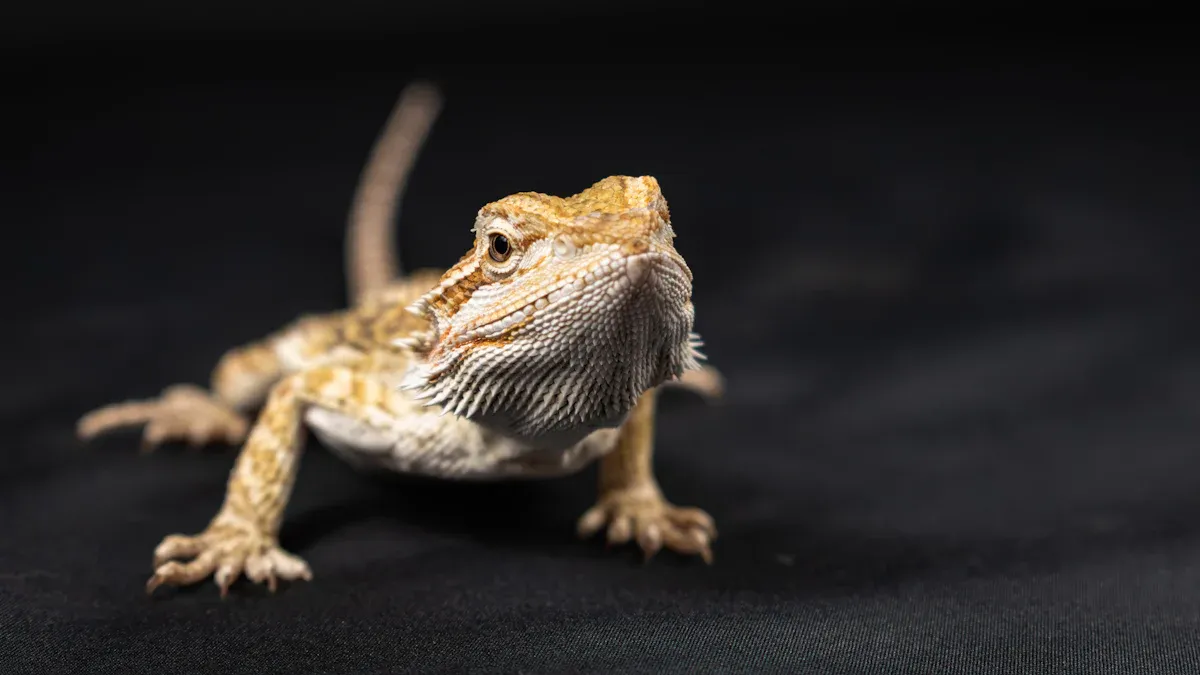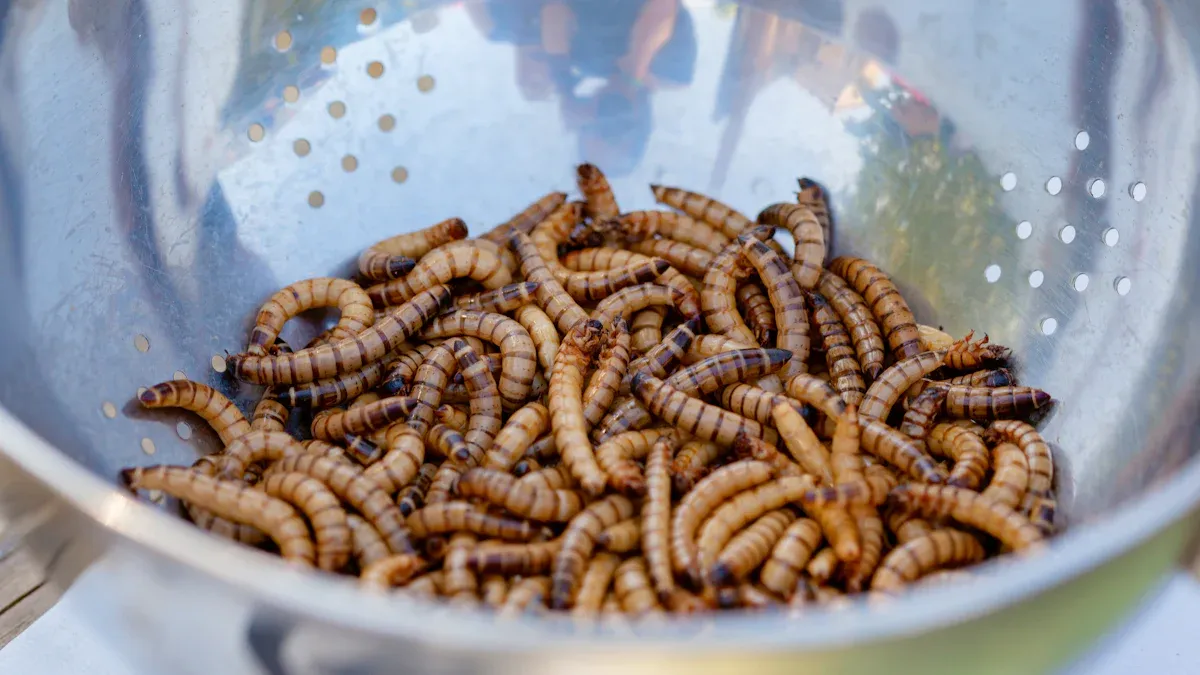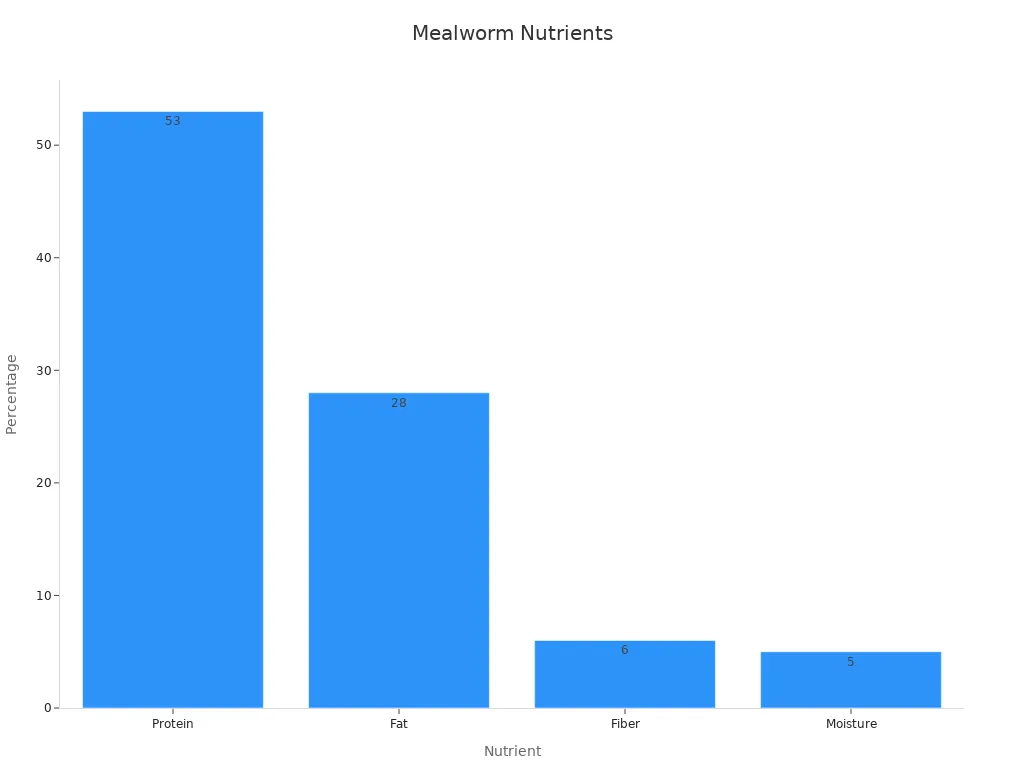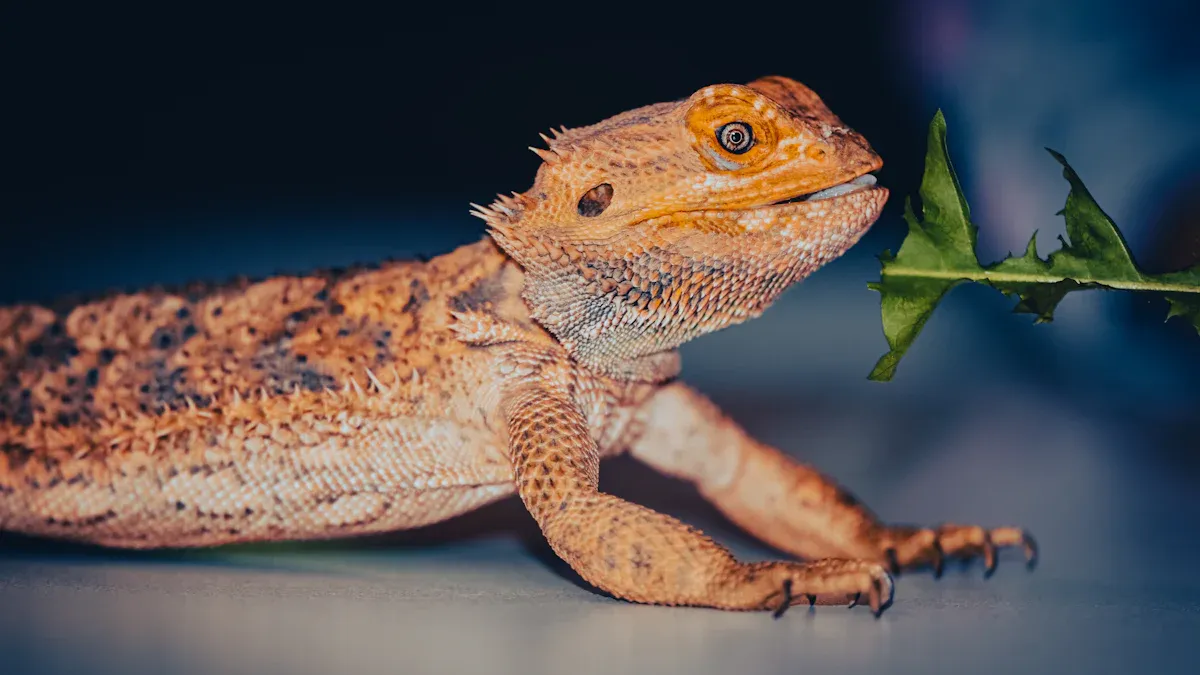
Dried mealworms are generally safe for bearded dragons when served correctly. They can even contribute to a balanced diet. However, owners should ensure variety in their pet’s meals. Bearded dragon dried mealworms provide protein and other nutrients, but they shouldn’t replace fresh vegetables and live insects for optimal health.
Key Takeaways
- Dried mealworms are an easy protein source for adult dragons. Give them in small amounts to prevent weight gain.
- Mix dried mealworms with calcium-rich foods and live bugs. This helps your dragon get all the nutrients it needs.
- Soak or crush dried mealworms before feeding them. This helps younger dragons digest them more easily.
Nutritional Value of Bearded Dragon Dried Mealworms

Protein and Fat Content
Dried mealworms are known for their high protein and fat content, making them a popular choice for feeding adult bearded dragons. Protein plays a vital role in maintaining muscle health and supporting growth, especially for dragons that are active or recovering from illness. However, the fat content in dried mealworms is also significant, which can lead to weight gain if fed in excess. For adult dragons, these mealworms can be a convenient protein source, but they should be offered in moderation to avoid potential health issues like obesity.
Calcium-to-Phosphorus Ratio
The calcium-to-phosphorus ratio in dried mealworms is a critical factor to consider. These mealworms have a ratio of approximately 0.33:1, which is far below the recommended range of 1.5:1 to 2:1 for bearded dragons. Calcium is essential for strong bones and preventing metabolic bone disease, a common health issue in reptiles. Unfortunately, the low calcium content in dried mealworms makes them unsuitable as a primary food source. Owners should pair them with calcium-rich foods or supplements to ensure their dragon gets the nutrients it needs.
Other Essential Nutrients
While dried mealworms provide some nutritional benefits, they lack the balance found in other feeder insects. Here’s a quick breakdown of their nutritional profile:
- High in fat and phosphorus.
- Low in calcium and protein compared to other insects like crickets or roaches.
- Limited variety in vitamins and minerals.
These mealworms can be a fun treat for your dragon, but they shouldn’t replace more nutritious options. A diet that includes a mix of live insects, fresh vegetables, and occasional dried mealworms ensures your pet stays healthy and happy.
Benefits of Bearded Dragon Dried Mealworms
Convenience and Shelf Life
Dried mealworms are incredibly convenient for bearded dragon owners. Unlike live insects, they don’t require special care or storage. You can keep them in a sealed container at room temperature, and they’ll stay fresh for months. This makes them a great option for busy pet owners who want to ensure their dragon always has a reliable food source. Plus, dried mealworms are mess-free and easy to portion out during feeding time.
Their long shelf life also means less waste. If you’ve ever had live insects die before your dragon could eat them, you’ll appreciate how dried mealworms solve this problem. They’re ready to use whenever you need them, making feeding time stress-free.
High Protein Content for Adult Dragons
Bearded dragon dried mealworms are packed with protein, which is essential for adult dragons. Protein helps maintain muscle health and supports overall energy levels. According to their nutritional profile, dried mealworms contain approximately 53% protein, making them a dense and efficient source of this vital nutrient.
Here’s a quick breakdown of their composition:
| Nutrient | Value |
|---|---|
| Protein | 53% |
| Fat | 28% |
| Fiber | 6% |
| Moisture | 5% |
This high protein content makes dried mealworms especially beneficial for adult dragons that are active or recovering from illness. However, it’s important to balance their diet with other foods to avoid overloading on fat.

Nutritional Density Compared to Live Mealworms
Dried mealworms are more nutritionally dense than their live counterparts. The drying process removes most of the moisture, leaving behind a concentrated source of nutrients. This means your dragon gets more protein and fat per gram of dried mealworms compared to live ones.
For owners looking to supplement their dragon’s diet with a protein boost, dried mealworms are a practical choice. They’re lightweight, easy to store, and provide a consistent nutritional profile. While they shouldn’t replace live insects entirely, they can be a valuable addition to a balanced diet.
Risks and Limitations of Bearded Dragon Dried Mealworms
Low Calcium-to-Phosphorus Ratio
One of the biggest concerns with dried mealworms is their poor calcium-to-phosphorus ratio. Bearded dragons need a diet rich in calcium to maintain strong bones and prevent health problems like metabolic bone disease (MBD). Unfortunately, dried mealworms have a calcium-to-phosphorus ratio of about 0.33:1, which falls far below the ideal range of 1.5:1 to 2:1.
Here’s a quick look at the risks associated with this imbalance:
| Issue | Description |
|---|---|
| Poor Calcium-to-Phosphorus Ratio | Mealworms lack the calcium needed for healthy bones in bearded dragons. |
| Risks of Excess Feeding | Overfeeding mealworms can lead to calcium deficiency and MBD in reptiles. |
| Importance of Gut-Loading | Gut-loading mealworms can improve their calcium content and reduce risks. |
To address this issue, owners can dust dried mealworms with calcium powder before feeding. Pairing them with calcium-rich foods like collard greens or mustard greens can also help balance the diet.
Risk of Overfeeding and Obesity
Dried mealworms are high in fat, which makes them a tasty treat for bearded dragons. However, too much fat can lead to weight gain and obesity. Adult dragons, in particular, are prone to becoming overweight if their diet isn’t carefully managed.
Overfeeding dried mealworms can also cause other health problems. For example, an overweight dragon may become less active and develop issues with its joints. To avoid these risks, owners should limit the number of dried mealworms they offer. A few mealworms as an occasional treat is fine, but they shouldn’t make up the bulk of a dragon’s diet.
Digestive Challenges for Younger Dragons
Younger bearded dragons have more sensitive digestive systems than adults. Dried mealworms can be harder for them to digest because of their tough exoskeletons. This can lead to impaction, a condition where undigested food blocks the digestive tract.
To keep younger dragons safe, it’s better to stick with softer, easier-to-digest foods like small crickets or freshly molted insects. If you do decide to offer dried mealworms, make sure they’re finely crushed or soaked in water to soften them. This makes them easier to chew and digest.
By understanding these risks, owners can make better choices when feeding bearded dragon dried mealworms. Moderation and proper preparation are key to keeping your pet healthy and happy.
Feeding Guidelines for Bearded Dragon Dried Mealworms

Portion Sizes and Feeding Frequency
Feeding dried mealworms to bearded dragons requires careful portion control. Adult dragons can enjoy a small handful of dried mealworms as an occasional treat, while younger dragons should receive even fewer due to their sensitive digestive systems. Offering dried mealworms once or twice a week is ideal for maintaining a balanced diet. Overfeeding can lead to health issues like obesity, so it’s important to keep portions small and infrequent.
When planning meals, consider your dragon’s age, activity level, and overall health. Active dragons may benefit from slightly larger portions, while less active ones should stick to smaller servings. Always monitor your pet’s weight and adjust feeding amounts as needed.
Balancing Dried Mealworms with Other Foods
A healthy diet for bearded dragons includes a mix of live insects, fresh vegetables, and occasional fruits. Dried mealworms can complement this variety but shouldn’t replace other food types. Live insects, such as crickets or dubia roaches, should make up about 70% of their diet. Vegetables like collard greens and squash provide essential vitamins, while fruits like berries can be offered sparingly.
Here are some tips for balancing dried mealworms with other foods:
- Pair dried mealworms with calcium-rich vegetables to offset their low calcium content.
- Gut-load live insects before feeding to boost their nutritional value.
- Use commercial foods as a supplement, not a replacement, for fresh and live options.
This variety ensures your dragon gets all the nutrients it needs to thrive.
Preparation Tips for Optimal Feeding
Preparing dried mealworms properly can make them easier for your dragon to eat and digest. Soaking them in warm water for a few minutes softens their texture, making them more palatable and digestible. For younger dragons, crush the mealworms into smaller pieces to reduce the risk of impaction.
Dusting dried mealworms with calcium powder is another great way to enhance their nutritional value. This simple step helps address their low calcium-to-phosphorus ratio. When serving, use a shallow dish to prevent mealworms from scattering and make cleanup easier.
🦎 Tip: Rotate dried mealworms with live insects and fresh vegetables to keep your dragon’s meals interesting and nutritious.
Dried mealworms offer protein and convenience but come with risks like low calcium and high fat. Moderation is key. Pair them with calcium-rich foods and live insects for balance. Soak or crush mealworms for easier digestion. 🦎 Tip: Keep meals varied to ensure your bearded dragon stays healthy and happy.
Author: Felix
FAQ
Can baby bearded dragons eat dried mealworms?
Baby dragons should avoid dried mealworms. Their tough exoskeletons can cause digestive issues. Stick to softer, live insects like small crickets or freshly molted worms for young dragons.
How often should dried mealworms be fed to adult dragons?
Offer dried mealworms once or twice a week as a treat. Keep portions small to prevent overfeeding and ensure a balanced diet with live insects and vegetables.
Should dried mealworms be soaked before feeding?
Yes, soaking dried mealworms in warm water softens them. This makes them easier to chew and digest, especially for younger or less active dragons.
🦎 Tip: Always monitor your dragon’s health and adjust feeding habits as needed. A varied diet keeps them happy and thriving!


